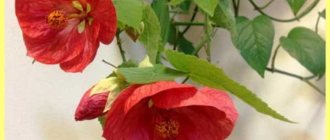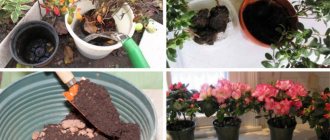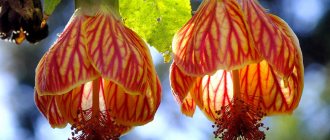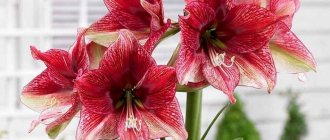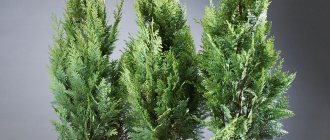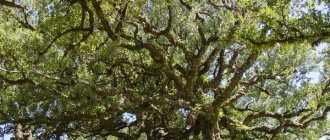In its natural habitat (tropics and subtropics), abutilon or ropewort is found everywhere in the wild, but in harsher climates it is grown exclusively as a decorative potted crop. Its advantages are the original shape of the leaves, for which it is called “indoor maple,” delicate bell-shaped buds, rapid growth and long-lasting flowering, up to six months or more. At the same time, caring for abutilone is very simple. Even a novice gardener can grow a healthy and beautiful plant, even if only briefly knowing how to care for it.
Features of caring for abutilone at home
To grow abutilone at home, preference should be given to hybrid varieties. They are distinguished by their compact crown and large flower sizes. In order for bright bells to bloom on your home maple from spring to late autumn, you need to comply with lighting conditions, temperature conditions, watering and fertilize on time.
Air temperature
Despite the fact that the abutilon maple is a southern plant, being constantly in a warm apartment is not good for it. The ideal temperature for a tropical “guest” in the warm season is +20 °C – +26 °C, and in winter it should be at +12 °C – +15 °C.
If the air cools to +5 °C - +10 °C, abutilon may begin to shed its leaves. Drafts pose no less danger to him. Too warm air can also negatively affect the condition of indoor maple. At a temperature of +30 °C, the formation of buds stops. To help the green pet, they resort to spraying the above-ground parts with warm, soft, settled water.
On summer days, abutilon responds well to being on a sunny veranda or balcony, and sometimes plants are successfully transferred to the garden or even transplanted into open ground.
Lighting
Abutilones are photophilous and need bright, diffused light. Its deficiency leads to a decrease in the number of buds on the bush. In this case, varieties with variegated (variegated) or light-colored leaves are slightly shaded. This helps maintain beautiful, clear patterns on them.
Abutilons on the windowsill in the apartment
Preferred places for growing indoor maple abutilon, which takes place in the house, are eastern, western, south-eastern and south-western window sills. Bushes located on the south side must be protected from the sun during the midday hours, otherwise their leaves will dry out. Plants placed on the windowsills of northern windows need additional lighting.
Watering
Abutilons love plenty of watering. Do not allow the soil in the pot to dry out. The need for moisture increases in hot weather or during cold periods when heaters are running in the apartment or the heating system is turned on. Timely watering is especially important during the growing season. Lack of moisture in this case inevitably leads to wilting, loss of buds, and sometimes to the death of the root system.
If abutilone lacks moisture, it begins to actively shed buds. Overwatering may be indicated by the drooping appearance of the plant.
You need to water your home maple tree at the moment when the soil dries out slightly after the previous watering. For this you should use settled or melted warm water. During cold wintering, the amount and abundance of watering is significantly reduced to prevent the appearance of rot.
Soil selection
The soil for home maple should be well permeable to air and moisture. This can be a universal soil intended for indoor plants with the addition of sand, vermiculite or perlite. The substrate for abutilone should not only be loose and light, but also have a neutral or slightly acidic pH reaction (within 6-7), and also be moisture- and breathable.
If you make the soil yourself, you will need to mix: 2 parts turf soil, 2 parts coniferous or deciduous humus, 0.5 parts river sand, 1 part coconut substrate. For drainage at the bottom of the pot (about 2 centimeters), it is recommended to use expanded clay or just small pebbles, as well as sphagnum moss (it is laid on top of the expanded clay before pouring the soil mixture, to create additional moisture exchange).
Feeding
Abutilon grows very quickly and is generally quite “voracious” for these reasons it needs constant feeding. They are applied from the onset of spring until autumn every two weeks. The abundance and quality of flowering depends on the regularity of fertilizing. It is recommended to alternate the application of mineral fertilizers with the addition of organic matter to the soil.
The concentration of fertilizers for abutilone may be less than in the instructions for the selected composition, but the flower needs to be fed a little more often. During the time of mass flowering, it is better to fertilize abutilon with products with a high content of phosphorus and potassium, which have a positive effect on the formation of buds. When, after pruning, abutilon must quickly grow new foliage, it is more correct to use preparations with nitrogen.
A lack of mineral fertilizers often leads to the fact that the leaves of abutilone begin to turn yellow; in this case, a drug called “Emerald” will help.
Types and varieties
In the natural environment, you can find at least two hundred species of abutilone, but only a small part of them is cultivated in indoor floriculture. This is basically:
Abutilon Darwin (lat. Abutilon darwinii). Tall, spreading species with large flowers and long, hairy shoots. The carved leaves also have a short edge and reach 20 cm in length. Pink flowers can be either single or collected in small inflorescences.
Abutilon sellowianum can often be found as an indoor plant. This is a large (up to 2 m), low-branching plant with pubescent shoots and leaves. The flowers are orange with a network of dark red veins.
Abutilon vitifolium is one of the tallest indoor representatives of the genus. Due to its large size (about 2.5 m), it is most suitable for greenhouses and winter gardens. The flowers are collected in inflorescences of 2-4 pieces, the petals have a delicate lilac tint.
A. Darwina, A. Sello, A. grapevine
Abutilon megapotamian or Amazonian (lat. Abutilon megapotamicum). It is distinguished by the unusual shape of single flowers, similar to lanterns. The leaves are elongated, rich green in color, the shoots are drooping, slightly pubescent. One of the advantages of the species is its almost year-round flowering.
Abutilon spotted, variegated or striped (lat. Abutilon pictum) is distinguished by the unusual color of leaves and flowers: light strokes on the leaf plate and a bright mesh on the petals. Such patterns on the plant are the result of selection, so spotted abutilon does not reproduce by seeds.
Abutilon hybrid (lat. Abutilon hybridum). An artificially bred hybrid of several natural species. Depending on the variety, it can have very different flower colors and bright or dark green leaves, both maple and heart-shaped. It is characterized by fast growth, high survival rate, and good bushiness. Perfectly suited for indoor growing.
A. megapotamian, A. spotted, A. hybrid
Based on the abutilones described above, a huge number of varieties have been developed, different in size, structure, color of flowers and leaves. It is perhaps impossible to list them all; it is worth noting only the most popular:
Yellow and orange abutilones
- "Moonchimes" (Moonbell) is a medium-sized (up to 50 cm) plant with large yellow funnel-shaped flowers.
- "Apollo" (Apollo) - lemon-yellow inflorescences against a background of rich green foliage.
- "Golden Fleece" is a large shrub, reaching 2 m in height, with rich yellow flowers. The shape of the petals is round, the sepals have a double color: purple-burgundy on the outside and yellow on the inside.
A. "Moonchimes", A. "Apollo", A. "Golden Fleece"
- "Orange Cascade" is a low-growing member of the genus with graceful bright orange bell-shaped flowers.
- “Orange Hot Lava” (Hot Lava) is an abutilon with original funnel-shaped flowers of an unusual color: bright orange petals with veins and dark burgundy bracts.
- "Orange King" is a hybrid variety with large flowers of a bright orange hue, the petals of which are decorated with a network of dark burgundy veins.
A. "Orange Cascade", A. "Orange Hot Lava", A. "Orange King"
Red and pink abutilones
- “Nabob” (Nabob) is a spectacular tall (up to 2 m) variety of hybrid indoor maple with dark red flowers. The petals are decorated with convex veins.
- "Ashford Red" (Ashford red) is a very tall shrub, the maximum size of which is 4-5 m, with large flowers of a rich red hue and large light green leaves.
- "Vesuvius Red" (Red Vesuvius) - has an unusual flower shape, similar to an erupting volcano. The color of the petals is bright red with veins, the bracts are burgundy-brown.
- "Red Princess" (Red Princess) - large flowers of a deep red-burgundy color, reminiscent of mallow in shape.
A. "Nabob", A. "Ashford Red", A. "Vesuvius Red"
- "Pink Parasol" (Pink Umbrella) is a low shrub with medium-sized lilac-pink flowers and dark green velvety leaves.
- "Mobile Pink" (Changable pink) - stands out for the unusual shape of wide-open flowers with a slightly wavy edge of the petals. The color of the buds is soft pink with a peach tint.
- "Victorian Lady" - luxurious deep pink double flowers visually resemble a rose. One of the most unusual and spectacular varieties of abutilone.
A. “Pink Parasol”, A. “Mobile Pink”, A. “Victorian Lady”
White and variegated abutilons
- "Silver Belle" (Silver Beauty) is a hybrid with arrow-shaped dark green leaves and snow-white flowers in yellow sepals.
- "White King" - beautiful drooping cream-colored flowers against a background of light green leaves.
- “Album” is a variety of grape-leaved abutilon, reaching impressive sizes (up to 3 m) with large white flowers collected in lush inflorescences.
A. "Silver Belle", A. "White King", A. "Album"
- “Souvenir de Bonn” (Souvenir de Bonn) is an original variety, the main decoration of which is elegant carved leaves with a dark green center and a light edge.
- “Salmon Variegated” (Salmon Variegated) - the leaf plate is decorated with chaotically located light spots on a dark background. The flowers are bell-shaped, salmon-colored.
- "Savitzii" (Savitsky) is a low shrub with small leaves. The main area of the leaf blade is creamy-green, with large bright green spots in the middle of the leaf.
A. "Souvenir de Bonn", A. "Salmon Variegated", A. "Savitzii"
How to care for abutilone in winter
Winter maintenance of the “southern guest” involves two options: warm and cold wintering.
Warm wintering
When keeping abutilone in a house on a windowsill in winter at temperatures from +18 °C to +22 °C, it is necessary to provide it with additional lighting. Several 20 W lamps are suitable for this.
The root system of indoor maple can be subject to hypothermia and rot. To protect the roots, you can place insulating material under the flower pot, such as a cork stand or a piece of foam.
Watering the abutilon should be moderate and should be done after half the pot has dried out the soil. Feeding is done leaf by leaf and only when signs of nutrient deficiency occur.
Cold winter
At home, a balcony or loggia can become a place for cold wintering of abutilon, but with one important condition: the air temperature should not fall below +8 °C. Watering should be moderate, closer to meager. It is carried out after the soil has dried out as much as possible. Fertilizers are not applied in winter until mid-February. It is better to choose soil for cold wintering that is breathable, loose and light.
In winter, when the air quality in the room is affected by heating devices, a screen made of non-woven material or film, separating the space under the window sill from the living space, will be a good protection from the heat.
Application, benefit, harm
Abutilon is used for decorative purposes (for example, ampere types look good against the background of a stretch ceiling). It also has technical uses after processing. From it they produce:
- rope burlap;
- ropes;
- ropes of high ktex and high-quality weaving.
That is why it has another name - cord. It does not have harmful properties, but for some people it becomes an allergen. There is a sign that the cord brings trouble to the home, but this is just superstition.
Fertilizers for abutilone
Indoor maple loves feeding and responds gratefully to it. At the same time, almost any composition is suitable for it. It makes sense to apply fertilizers for abutilone from the onset of spring until autumn, and experienced gardeners recommend diluting them in a slightly lower concentration than suggested in the instructions for the selected composition. Fertilizing ends in October.
When the time for active flowering comes, the bush is fertilized with products saturated with potassium and fluorine. They promote the formation of buds. After pruning branches and during the period of active growth of green mass, it is useful to apply nitrogen-containing preparations. And when it becomes discolored, signaling a deficiency of microelements, the plant is fed with complex organomineral fertilizer, for example, “Emerald”.
In summer, you can reduce the intervals for fertilizing the soil to once every 2 weeks. From about November until spring, it is enough to feed the substrate once a month or stop feeding altogether so that the plant can rest.
Is it suitable for shaping bonsai?
Abutilone is rarely used for bonsai formation because it is slow in growth and often gets sick. The formation of a tree can be carried out by observing the following rules:
- prune when the plant has 5 pairs of leaves, shortening it by 2–4 leaves;
- cuttings should be left, removing large leaf blades, which will fade over time and be replaced by smaller leaves;
- in mid-summer, the growth buds should be plucked out, which will cause a slowdown in growth and the formation of shorter shoots suitable for bonsai;
- pruning is carried out in summer and early autumn. At this time, wounds on the plant heal faster, and the recovery period takes a shorter period of time.
Abutilon is an unpretentious indoor plant that gives solar energy to others. With proper care and attention, a flower can become a worthy decoration for a living space.
Abutilone diseases
If the green “pet” is cared for in a timely and correct manner, nothing threatens it. If not properly cared for, indoor maple can be exposed to diseases and pests. Symptoms and reasons for their appearance may be different, as well as ways to help the flower.
Flowering problems
The first buds bloom on it 3-5 months after sowing the seeds. But sometimes all the permissible deadlines pass, and the home maple does not bloom. This means that he does not have enough strength to set and open the buds.
There are two main reasons why abutilon does not bloom:
- lack of lighting (the plant requires at least 2 hours of bright sunlight per day);
- excessively large volume of the flower pot: the bush spends too much effort filling it with the root system.
Sometimes abutilone drops its buds. Possible reasons for this phenomenon:
- insufficient watering, especially in spring and summer;
- nutrient deficiency, need for additional feeding;
- exposure to drafts; indoor maple does not tolerate them.
Problems with leaves
If the leaves of indoor maple are not properly cared for, problems of different nature and varying degrees of complexity can also arise. Each of them needs to be addressed individually:
- Abutilone sheds its leaves, they turn yellow and fall off. In some varieties, this indicates the onset of a dormant period in winter. Also, the reason may lie in damage to the root system or lack of nutrition.
- Abutilone leaves curl. The flower may be exposed to direct sunlight, the air humidity may be too low, and the temperature may be too high. To help him, it is worth trying to change the conditions of his detention.
- The lower leaves turn yellow. The reasons may be related to a lack of light or fertilizing. The flower pot should be moved to a more illuminated place, complex fertilizer should be applied, and the bush should also be inspected for the presence of pests, for example, spider mites.
- Leaves are lighter than usual. This is due to insufficient frequency of watering, lack of microelements, lack of sunlight and fresh air. To help the flower, you should water it more often, but with less water, move the pot to a brighter, ventilated room and feed it with complex fertilizer.
- Rust spots on green material. This is the result of infection by rust fungi. To combat the disease, affected leaves and shoots are removed. The bush is sprayed with the systemic fungicide Topaz, which is effective not only against rust, but also powdery mildew, spores and mycelium of pathogenic fungi. It can also be used for prevention: spray the flower at the beginning of the growing season.
Possible problems
If abutilone is not properly cared for, it will give you a signal by changing its condition. You just need to read it correctly and immediately take measures to eliminate the problem.
Drops buds and leaves
You are watering the plant incorrectly. The bush may suffer from drying out or, on the contrary, you overwater it, and stagnation of liquid will form in the pot.
If everything is fine with watering, it means that you are subjecting the plant to difficult tests - drafts and temperature changes.
The leaves are turning pale
Pale leaves signal a lack of light. Move the pot with abutilone to another, better lit window. Just accustom him to this joy gradually. Place it on the south side for one hour at first, and increase the time interval every day. If the apartment does not have windows facing south, add lamp lighting. Do this just as carefully and in doses.
The tips of the leaves are drying out
You have become dry and need urgent moisturizing. In hot weather, spray the leaves with a spray bottle, just make sure that drops of water do not fall on the flowers. In winter, you can place an open container of water on the windowsill next to the pot.
The lower leaves fall off
This happens if the soil is depleted. It is urgent to feed the bush with fertilizers. A lack of nutrients can also lead to yellowing of the leaves or the appearance of spots on the leaf blade.
Pests of abutilons
Indoor maples are disease resistant. But it can be attacked by insects and other pests. Bushes are most vulnerable in the spring, when parasites are actively multiplying, and the immunity of green pets is weakened after wintering and cannot fully resist them.
The main pests of abutilone:
- Scale insects. When they appear, abutilon becomes covered with sticky secretions, and then with small brown plaques. To remove pests, you can use a cotton pad and treat the bush with an insecticide solution, for example, actara or soap solution.
- Spider mites. Signs of their presence in a pot with a plant are the presence of gray or black specks on the inner surface of the leaves, as well as thin cobwebs. You can cope with this pest using agrovertin or fitoverm. The treatment must be carried out several times, with a week break.
- Aphid. Causes considerable harm to rope riders and infects them with viral diseases. When aphids appear, you can use an agrovertine solution or use folk remedies. For example, once a week it is allowed to treat the bush with an infusion of garlic and laundry soap.
Description
The genus includes: perennial evergreen and deciduous varieties; bushes, trees. They have woody or herbaceous shoots. Reach a height of 4 m in their natural environment.
- On the long stem there are harsh fibers or soft felt. Usually the shoots branch heavily.
- The leaves are dissected into several lobes. They are similar to maple trees: dark greenish or gray in tone with a blue tint and pointed ends. Therefore, abutilion has a popular name - indoor maple.
- In some representatives, the greens have a striped or speckled appearance. The length of the leaves does not exceed ten centimeters. Not all of them are maple-shaped; variegated varieties have heart-shaped greens.
When flowering, bell-shaped buds are formed. Their diameter reaches eleven centimeters. There are types of terry abutilon with large corolla petals. The flower has different colors (depending on the subspecies). More often the flowers are single, formed in the axils of greenery.
How to trim abutilon
Indoor maple at home can grow up to 1.5 meters in height. Without pruning, it loses its shape, the inflorescences are located only at the ends of the shoots. To form a compact bush or standard tree, it is necessary to prune the shoots in spring and autumn, leaving half or a third of their original length. Abutilon feels comfortable after pruning and pinching, completely restoring the volume of green mass in a few weeks.
To form a compact bush or standard tree, pruning is indispensable. Shoots are cut and pinched in autumn and spring to half or a third of their original length.
In order for abutilon to bush well, dried and damaged branches should be regularly cut off from a faded bush and the crown should be thinned out. And in the spring, adjustments to the crown shape must be repeated. Thanks to pruning, dormant buds awaken and side branches appear. After this procedure, the plant must be fed. When forming a trunk, to give the plant stability so that the bush does not droop its branches, it is recommended to install supports.
All articles about abutilones on the site can be read by following this link...
The abutilon flower is the dream of many home flora lovers. This potted plant combines ease of care, unpretentiousness and high decorativeness. Pay attention to the green “pet” and every year, from spring to late autumn, it will delight you with abundant and colorful flowering.
Reproduction: step-by-step instructions
Propagated by seeds, step by step instructions:
- The soil is sifted for looseness and better moisture retention. Low acidity soil is disinfected with a manganese solution.
- The seed is soaked in lukewarm water for 12 hours.
- Seeds are planted in pots to a depth of 5 mm. The pot is covered with polyethylene and placed in a warm place under the sun. Seedlings emerge from sprouted seeds in about three weeks.
- When the greenery is formed, the sprouts are transplanted into separate containers with a diameter of 7 cm.
The vegetative propagation method is best used in August:
- Take a 12 cm root with a flexible stem. The lower buds and greenery are removed.
- The shoots are planted in small containers and covered with jars (favorable greenhouse conditions are created). After about a month, the shoots take root. We must not forget to water, irrigate, and ventilate.
- Planting of mature seedlings is done in pots with a diameter of no more than 7 cm.
